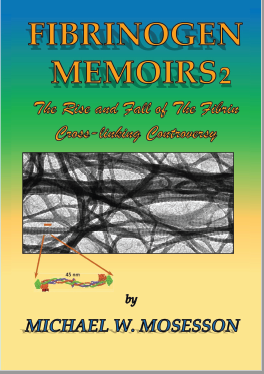Fibrinogen Memoirs 2: The Rise and Fall of the Fibrin Cross-linking Controversy by Michael W. Mosesson
$25.95
Click Here to Read: Kirkus Review of this book.
The Rise and Fall of the Fibrin Cross-linking Controversy concerns the longstanding controversy over the arrangement of ‘cross-linked’ structures within fibrin clots. The narrative covers the period from its origins to its unexpected decline and demise. The decades-long unresolved dispute over whether the cross-links were arranged in a ‘longitudinal’ or a ‘transverse’ position was replaced by the dogma that they were ‘longitudinal’, a structural arrangement that could not account for fibrin’s known elastic properties. The alternative bond arrangement, transverse, was no longer mentioned, despite an overwhelming body of evidence for its existence. This realization, coupled with the understanding that only a transverse bond arrangement could account for fibrin elasticity, prompted the Author to write the second volume of Fibrinogen Memoirs.
“These recollections are very informative since they provide readers with invaluable insights of fibrinogen science and the people who stood at the origins and development of this field. Michael’s talented writing makes this book easily digestible, even for people who have little scientific background. Thus, this book will be interesting not only for scientists involved in fibrinogen research but also for students with biomedical research trajectories, especially in the field of thrombosis and haemostasis.”
Leonid Medved, Ph.D., Professor of Biochemistry and Molecular Biology, University of Maryland School of Medicine.
The Rise and Fall of the Fibrin Cross-linking Controversy describes the genesis, maturation, and demise of a decades-long controversy over the arrangements of cross-linked chains in fibrin clots, and their potential roles in accounting for fibrin’s elasticity, one of its known biomechanical properties. The controversy was replaced by an assumption that the so-called ‘Longitudinal’ cross-linking arrangement was the extant structure, plus the implication that it accounted for fibrin’s biomechanical properties. The alternative cross-linking arrangement, ‘Transverse’, as championed by Mosesson, was no longer a consideration even though it is the only cross-link arrangement that can account for fibrin’s perfect elasticity. This untenable situation motivated the Author to write Fibrinogen Memoirs 2.
Why The Author Wrote Fibrinogen Memoirs 2
Fibrinogen Memoirs: Journeys of a Clot Doctor by Michael Mosesson, contained chapters on the structure, physiology, and metabolism of Fibrinogen and Fibrin. One chapter, “Fibrin—The Perfect Bioelastomer,” described a dispute known as “The Fibrin Cross-linking Controversy’” that began in 1985 and lasted for twenty years. It reached an apex in 2004 with published debate articles authored by two of the protagonists, after which interest in the controversy declined precipitously, as documented in the narrative up to 2010..
As chronicled in that chapter, the argument concerned the putative arrangement of covalent ‘cross-linked’ bonds within an assembled fibrin polymer. Two mutually exclusive bond arrangements were proffered and termed “longitudinal” and “transverse,” respectively. After considering the evidence, Mosesson concluded that these bonds were aligned transversely and that evidence for a longitudinal arrangement was lacking.
As a corollary he also concluded that there was an ineluctable relationship between a transverse bond arrangement and the well-known elastic recovery displayed by a fibrin clot after undergoing deformation by stretching. In stark contrast, longitudinal bond positioning would result instead in inelastic viscous deformation after a stretch without elastic recovery.
Fibrinogen Memoirs 2: The Rise and Fall of the Fibrin Cross-linking Controversy, is a sequel to “Fibrin—The Perfect Bioelastomer” that extends the timeline of controversy decline by an additional ten years (2010 to 2020). During that decade, several investigations were published on the biomechanical properties of fibrin. In all cases, the investigators assumed that cross-linked bonds in their fibrin specimens were arranged longitudinally. By selecting that bond arrangement, they did not account correctly for biomechanical properties such as fibrin elasticity. That unjustified presumption and the erroneous interpretations it engendered about fibrin biomechanical properties, stimulated the Author to write Fibrinogen Memoirs 2.
Michael Mosesson, the author of this book, is one of the leading scientists in the fibrinogen field who made seminal contributions to our understanding of how fibrinogen is converted to fibrin and subsequently participates in thrombosis and hemostasis. One of them, the discovery of transverse cross-linking in fibrin by plasma transglutaminase Factor XIII and his fight for the acceptance of his discovery by other scientists is the major focus of this book. Dr. Mosesson’s discovery was not in agreement with the hypothesis dominated that time, namely that the cross-linking in fibrin occurs in the longitudinal manner. This was the beginning of “the rise of the fibrin cross-linking controversy” mentioned by the author. Being a fibrinogen fan and a scientist who devoted most of my scientific career to the study of fibrinogen structure and function, I was following this controversy with keen interest, and I have an impression that this issue is still unresolved. Thus, this book is an appeal to the fibrinogen community to continue paying close attention to this controversy.
Although the major focus of this book is on the cross-linking controversy, it also contains author’s recollections about his colleagues with whom he collaborated and/or encountered during his long scientific career. They include such outstanding scientists as Birger Blombäck and John Ferry, who played a prominent role in establishing the fibrinogen field, Lazlo Lorand who discovered together with Koloman Laki Factor XIII, and Russ Doolittle who made numerous seminal contributions to the fibrinogen field. Michael Mosesson and John Weisel, who were the major opponents on the crosslinking controversy, also belong to this cohort of scientists. These recollections are very informative since they provide the readers with invaluable insight of the fibrinogen science and the people who stood at the origins and development of this field. Michael’s talented writing makes this book easily digestible even for people who have little scientific background. Thus, this book will be interesting not only for scientists involved in the fibrinogen research but also for students with the biomedical research career trajectories, especially in the field of thrombosis and haemostasis.
.—Leonid Medved, Ph.D. Professor of Biochemistry and Molecular Biology, Center for Vascular and Inflammatory Diseases, University of Maryland School of Medicine.
Fibrinogen and its crosslinked form (fibrin) are at the epicenter of survival and death. Without them a small cut would hemorrhage and a person would bleed to death. Heart attacks and stroke are caused by clots composed of crosslinked fibrinogen. In this memoir, Dr. Mosesson, a world-renowned expert in this field, elucidates just how the crosslinking takes place. But the memoir is more than that. It is a history lesson in scientific discovery spanning over about 40 years that introduces us to the major players in that discipline as a tight knit groups of scientists all seeking the truth, and often at odds with interpreting data as it is found. The story recounts the many personal interactions between this band of scientists from around the world. I will not give away the ending of how fibrinogen crosslinks, but let the reader enjoy the path.
–James F. Hainfeld, Ph.D., President, NANOPROBES, Inc.
In stock




